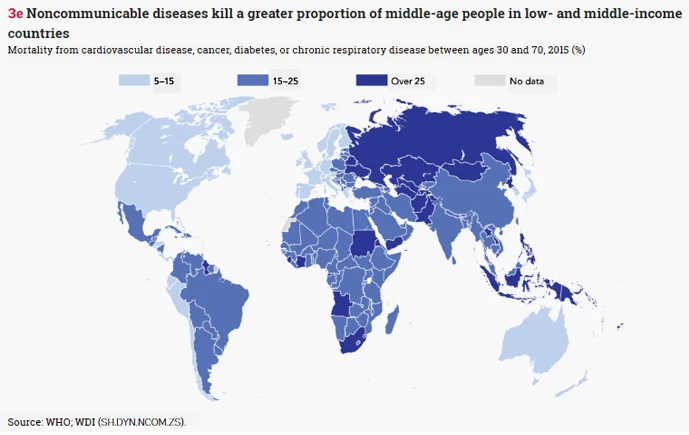This blog is part of a series using data from World Development Indicators to explore progress towards the Sustainable Development Goals and their associated targets. The new Atlas of Sustainable Development Goals 2017, published in April 2017, and the SDG Dashboard provide in-depth analyses of all 17 goals.
Communicable diseases cause more premature deaths in Sub-Saharan Africa than elsewhere in the world. But high rates of death through noncommunicable diseases are found in other regions as well. A higher number of health care professionals available to patients correlates with lower mortality before the age of 70, and, as newer drugs to prevent or treat disease come onto market, countries are seeing falls in the incidence of fatal diseases. Data from the World Bank’s World Development Indicators explores progress made towards the targets of Sustainable Development Goal 3, which promotes Good Health and Well-Being at all ages.
Sub-Saharan Africa bears the brunt of communicable diseases
AIDS, tuberculosis, and malaria together affect hundreds of millions of people worldwide, and putting an end to these diseases is a priority under Goal 3 (target 3.3). People in Sub-Saharan Africa are more likely than those in other regions to become infected: 2.2 of every 1,000 uninfected people ages 15-49 contracted HIV in 2016; there were 276 new cases of tuberculosis per 100,000 people in 2015; and the incidence of malaria was 234 cases per 1,000 persons at risk.
However, the region has shown improvements in tackling these diseases, the incidence of new cases of HIV has declined by nearly two-thirds since 2000, the incidence of new cases of malaria by nearly a half, and the incidence of new cases of tuberculosis by a fifth over the same period.
Middle-age people in low- and middle-income countries have a greater risk of dying from noncommunicable diseases than those in high-income countries
Goal 3 also recognizes that premature death from non-communicable diseases (NCDs) is largely preventable (target 3.4).
Mortality from cardiovascular disease, cancer, diabetes, or chronic respiratory disease between the ages of 30 and 70 occurs across the world, but is more prevalent in low- and middle-income countries. While these diseases also affect the populations of high-income countries, better health care may either prevent the onset to a later age, or may intervene to cure or to prolong life.
In low- and middle-income countries as the incidence of, and deaths from, communicable diseases such as HIV, malaria and tuberculosis fall, the share of deaths from noncommunicable diseases increases. In Botswana, for example, the proportion of deaths from NCDs of total deaths have increased by 150 percent since 2000, while the incidences of both HIV and tuberculosis has decreased by around two-thirds, and that of malaria is now just 2 percent of what it was fifteen years ago.
Low-income countries often have an insufficient health workforce.
Goal 3 recognizes that trained staff can help to reduce diseases and mortality, and calls for increasing the health workforce in countries where it is sparse (target 3.c). On average, there are only 1.4 health workers (physicians, nurses, and midwives) per 1000 population in Sub-Saharan Africa and 2.4 in South Asia: these figures contrast sharply with trained health staff available in high-income countries (11.7 per 1000 population on average around 2012).





Join the Conversation